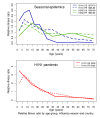Comparative age distribution of influenza morbidity and mortality during seasonal influenza epidemics and the 2009 H1N1 pandemic
- PMID: 20534113
- PMCID: PMC2896934
- DOI: 10.1186/1471-2334-10-162
Comparative age distribution of influenza morbidity and mortality during seasonal influenza epidemics and the 2009 H1N1 pandemic
Abstract
Background: Several studies have shown a relatively high mortality rate among young people infected by the 2009 pandemic influenza A (H1N1) virus. Here we compared the age distributions of morbidity and mortality during two seasonal influenza epidemics (H1N1 and H3N2) in France and the United States with those of the 2009 H1N1 pandemic waves in the same countries.
Methods: Age-standardized ratios were used to compare the age distribution of morbidity and mortality due to influenza between the two countries and across the different years. Non parametric analysis of variance was used to compare these ratios between epidemic and pandemic influenza.
Results: Age distribution of morbidity was similar between the 2009 pandemic and seasonal epidemics due to H1N1 (p = 0.72) and H3N2 viruses (p = 0.68). In contrast, the proportion of under-60s among influenza deaths was markedly higher during the 2009 pandemic (peak <20 years) than during the seasonal epidemics (respectively p = 0.007 and p = 0.0008).
Conclusions: Young age was a principal mortality risk factor due to the 2009 H1N1 pandemic.
Figures


References
-
- World Health Organisation. http://www.who.int/csr/don/2010_01_08/en/index.html
-
- Perez-Padilla R, de la Rosa-Zamboni D, Ponce de Leon S, Hernandez M, Quinones-Falconi F, Bautista E, Ramirez-Venegas A, Rojas-Serrano J, Ormsby CE, Corrales A. Pneumonia and Respiratory Failure from Swine-Origin Influenza A (H1N1) in Mexico. N Engl J Med. 2009;361(7):680–9. doi: 10.1056/NEJMoa0904252. - DOI - PubMed
-
- Dawood FS, Jain S, Finelli L, Shaw MW, Lindstrom S, Garten RJ. Emergence of a novel swine-origin influenza A (H1N1) virus in humans. N Engl J Med. 2009;361 - PubMed
-
- Serum cross-reactive antibody response to a novel influenza A (H1N1) virus after vaccination with seasonal influenza vaccine. MMWR Morb Mortal Wkly Rep. 2009;58(19):521–524. - PubMed
Publication types
MeSH terms
LinkOut - more resources
Full Text Sources
Medical

